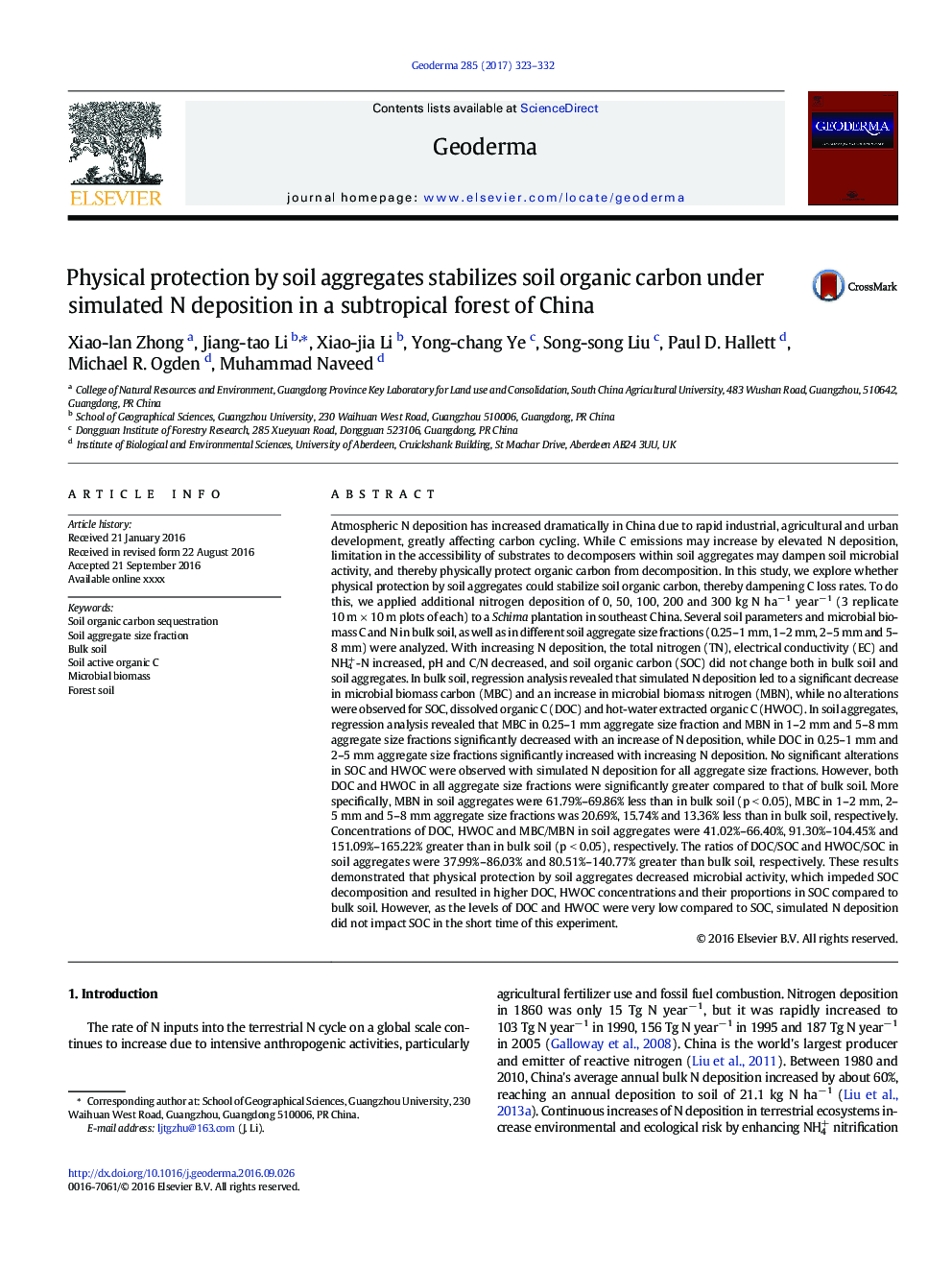| کد مقاله | کد نشریه | سال انتشار | مقاله انگلیسی | نسخه تمام متن |
|---|---|---|---|---|
| 6408239 | 1629432 | 2017 | 10 صفحه PDF | دانلود رایگان |
عنوان انگلیسی مقاله ISI
Physical protection by soil aggregates stabilizes soil organic carbon under simulated N deposition in a subtropical forest of China
دانلود مقاله + سفارش ترجمه
دانلود مقاله ISI انگلیسی
رایگان برای ایرانیان
کلمات کلیدی
موضوعات مرتبط
مهندسی و علوم پایه
علوم زمین و سیارات
فرآیندهای سطح زمین
پیش نمایش صفحه اول مقاله

چکیده انگلیسی
Atmospheric N deposition has increased dramatically in China due to rapid industrial, agricultural and urban development, greatly affecting carbon cycling. While C emissions may increase by elevated N deposition, limitation in the accessibility of substrates to decomposers within soil aggregates may dampen soil microbial activity, and thereby physically protect organic carbon from decomposition. In this study, we explore whether physical protection by soil aggregates could stabilize soil organic carbon, thereby dampening C loss rates. To do this, we applied additional nitrogen deposition of 0, 50, 100, 200 and 300 kg N haâ 1 yearâ 1 (3 replicate 10 m Ã 10 m plots of each) to a Schima plantation in southeast China. Several soil parameters and microbial biomass C and N in bulk soil, as well as in different soil aggregate size fractions (0.25-1 mm, 1-2 mm, 2-5 mm and 5-8 mm) were analyzed. With increasing N deposition, the total nitrogen (TN), electrical conductivity (EC) and NH4+-N increased, pH and C/N decreased, and soil organic carbon (SOC) did not change both in bulk soil and soil aggregates. In bulk soil, regression analysis revealed that simulated N deposition led to a significant decrease in microbial biomass carbon (MBC) and an increase in microbial biomass nitrogen (MBN), while no alterations were observed for SOC, dissolved organic C (DOC) and hot-water extracted organic C (HWOC). In soil aggregates, regression analysis revealed that MBC in 0.25-1 mm aggregate size fraction and MBN in 1-2 mm and 5-8 mm aggregate size fractions significantly decreased with an increase of N deposition, while DOC in 0.25-1 mm and 2-5 mm aggregate size fractions significantly increased with increasing N deposition. No significant alterations in SOC and HWOC were observed with simulated N deposition for all aggregate size fractions. However, both DOC and HWOC in all aggregate size fractions were significantly greater compared to that of bulk soil. More specifically, MBN in soil aggregates were 61.79%-69.86% less than in bulk soil (p < 0.05), MBC in 1-2 mm, 2-5 mm and 5-8 mm aggregate size fractions was 20.69%, 15.74% and 13.36% less than in bulk soil, respectively. Concentrations of DOC, HWOC and MBC/MBN in soil aggregates were 41.02%-66.40%, 91.30%-104.45% and 151.09%-165.22% greater than in bulk soil (p < 0.05), respectively. The ratios of DOC/SOC and HWOC/SOC in soil aggregates were 37.99%-86.03% and 80.51%-140.77% greater than bulk soil, respectively. These results demonstrated that physical protection by soil aggregates decreased microbial activity, which impeded SOC decomposition and resulted in higher DOC, HWOC concentrations and their proportions in SOC compared to bulk soil. However, as the levels of DOC and HWOC were very low compared to SOC, simulated N deposition did not impact SOC in the short time of this experiment.
ناشر
Database: Elsevier - ScienceDirect (ساینس دایرکت)
Journal: Geoderma - Volume 285, 1 January 2017, Pages 323-332
Journal: Geoderma - Volume 285, 1 January 2017, Pages 323-332
نویسندگان
Xiao-lan Zhong, Jiang-tao Li, Xiao-jia Li, Yong-chang Ye, Song-song Liu, Paul D. Hallett, Michael R. Ogden, Muhammad Naveed,